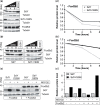A nonfunctional copy of the salmonid sex-determining gene (sdY) is responsible for the "apparent" XY females in Chinook salmon, Oncorhynchus tshawytscha
- PMID: 35100376
- PMCID: PMC8824802
- DOI: 10.1093/g3journal/jkab451
A nonfunctional copy of the salmonid sex-determining gene (sdY) is responsible for the "apparent" XY females in Chinook salmon, Oncorhynchus tshawytscha
Abstract
Many salmonids have a male heterogametic (XX/XY) sex determination system, and they are supposed to have a conserved master sex-determining gene (sdY) that interacts at the protein level with Foxl2 leading to the blockage of the synergistic induction of Foxl2 and Nr5a1 of the cyp19a1a promoter. However, this hypothesis of a conserved master sex-determining role of sdY in salmonids is challenged by a few exceptions, one of them being the presence of naturally occurring "apparent" XY Chinook salmon, Oncorhynchus tshawytscha, females. Here, we show that some XY Chinook salmon females have a sdY gene (sdY-N183), with 1 missense mutation leading to a substitution of a conserved isoleucine to an asparagine (I183N). In contrast, Chinook salmon males have both a nonmutated sdY-I183 gene and the missense mutation sdY-N183 gene. The 3-dimensional model of SdY-I183N predicts that the I183N hydrophobic to hydrophilic amino acid change leads to a modification in the SdY β-sandwich structure. Using in vitro cell transfection assays, we found that SdY-I183N, like the wild-type SdY, is preferentially localized in the cytoplasm. However, compared to wild-type SdY, SdY-I183N is more prone to degradation, its nuclear translocation by Foxl2 is reduced, and SdY-I183N is unable to significantly repress the synergistic Foxl2/Nr5a1 induction of the cyp19a1a promoter. Altogether, our results suggest that the sdY-N183 gene of XY Chinook females is nonfunctional and that SdY-I183N is no longer able to promote testicular differentiation by impairing the synthesis of estrogens in the early differentiating gonads of wild Chinook salmon XY females.
Keywords: sdY; XY females; salmonids; sex determination; sex reversal.
© The Author(s) 2022. Published by Oxford University Press on behalf of Genetics Society of America.
Figures






References
-
- Baroiller J-F, D'Cotta H.. The reversible sex of gonochoristic fish: insights and consequences. Sex Dev. 2016;10(5–6):242–266. - PubMed
Publication types
MeSH terms
LinkOut - more resources
Full Text Sources
